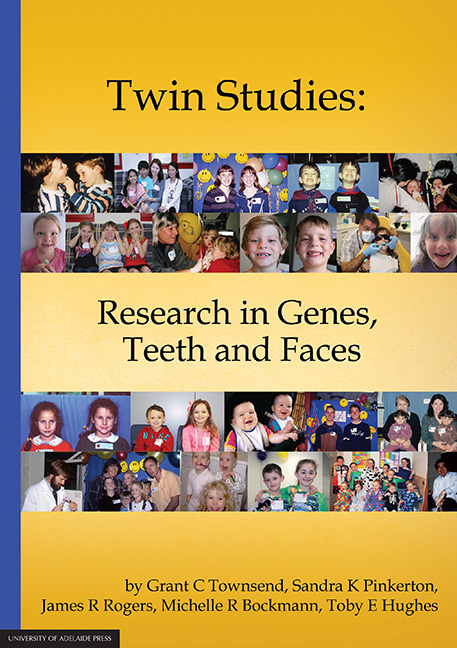Book contents
- Frontmatter
- Foreword
- Preface
- Dedication
- Photographic acknowledgements
- Ethical approval
- Acknowledgements
- Contents
- Chapter One A tour of the mouth
- Chapter Two A historical perspective
- Chapter Three Phases of research involving twin studies of teeth and faces
- Chapter Four Cohort 1: Teeth and faces of South Australian teenage twins
- Chapter Five Cohort 2 – A longitudinal study of dental and facial development in Australian twins and their families
- Chapter Six Cohort 3 – Tooth emergence and oral health in Australian twins and their families
- Chapter Seven Publications and theses relating to the Adelaide Twin Studies
- Glossary of terms
- Appendix 1
Chapter Three - Phases of research involving twin studies of teeth and faces
Published online by Cambridge University Press: 05 February 2016
- Frontmatter
- Foreword
- Preface
- Dedication
- Photographic acknowledgements
- Ethical approval
- Acknowledgements
- Contents
- Chapter One A tour of the mouth
- Chapter Two A historical perspective
- Chapter Three Phases of research involving twin studies of teeth and faces
- Chapter Four Cohort 1: Teeth and faces of South Australian teenage twins
- Chapter Five Cohort 2 – A longitudinal study of dental and facial development in Australian twins and their families
- Chapter Six Cohort 3 – Tooth emergence and oral health in Australian twins and their families
- Chapter Seven Publications and theses relating to the Adelaide Twin Studies
- Glossary of terms
- Appendix 1
Summary
Three broad phases of research can be identified where twins have been studied to understand more about the contribution of genetic and environmental factors to human dental and facial variation. The number and types of studies have increased dramatically since the early 1900s.
Studies of twin resemblance: hereditary and environmental influences
1920s-1940s
An initial phase of studies can be identified in the period from the 1920s to the early 1940s (see Table 3.1 at the end of this section for a summary of these studies). Several researchers around the world began studies of twins which highlighted resemblances of dental structures. Through being able to identify similarities in dental tissues they began to separate what could be thought of as genetically influenced (or hereditary) factors from environmentally influenced ones (Bachrach and Young, 1927; Goldberg, 1930; Korkhaus,1930; Newman 1923, 1928a,b, 1930; Newman et al.,1937). Indeed, publications involving Horatio H Newman commenced as early as 1913.
Henriette Bachrach and Matthew Young (1927) studied the resemblances of dental features in twin pairs who had been grouped into so-called identical pairs (development of more than one embryo from a fertilised egg) and non-identical pairs (development of embryos from separate fertilised eggs). The reason for forming these groupings conformed to the general belief that identical twin pairs shared the same inherited characteristics and that non-identical twin pairs shared only part of their inherited characteristics.
Using these two twin categories they set out to compare the degrees of influence that heredity and environment had upon chosen dental characteristics. These included tooth eruption times, dental caries in deciduous and permanent teeth, enamel hypoplasia, the state of dental occlusion and gingivitis. With the exception of total caries prevalence, data collected for all of the other features (particularly in subjects displaying different degrees of malocclusion) showed that correlations were higher in identical twin pairs than in non-identical twin pairs. This study and its choice of multiple dental features provided an important foundation for future studies involving dental morphology and disease in twins.
A paper written by Samuel Goldberg (1930) reported on dental arch size and shape in identical twins. His research considered resemblances of arch symmetry and asymmetry, as well as mirror imaging, in monozygotic twin pairs. Goldberg attempted to determine both the degree of arch variation and the severity of dental malocclusion.
- Type
- Chapter
- Information
- Twin StudiesResearch in Genes, Teeth and Faces, pp. 62 - 86Publisher: The University of Adelaide PressPrint publication year: 2015



